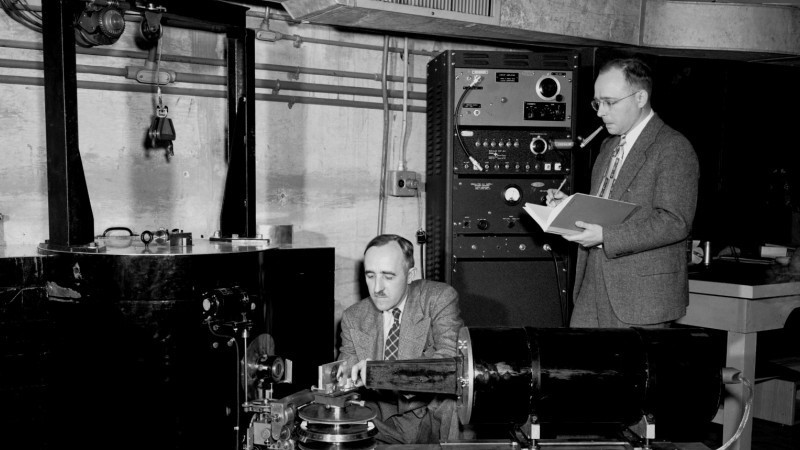On December 22, 1944, Ernest Wollan pioneered neutron diffraction techniques at what is now the Department of Energy’s (DOE’s) Oak Ridge National Laboratory (ORNL), laying the foundation for ORNL’s neutron scattering program and similar programs around the world.
Wollan, who had a background in x-ray physics, was exploring the possibility of diffracting neutrons to measure nuclear materials for the Manhattan Project.
Diffraction is a technique researchers use to better understand the atomic and magnetic makeup of a material. Quantum particles like electrons, photons, and neutrons—which behave like waves at the atomic length scale—are scattered off the layers of atoms in a crystalline material and tracked using a special detector. Wollan believed diffracting neutrons would provide researchers with previously unobtainable data about the internal structures of a wide variety of materials. Other researchers had already demonstrated in the 1930s that neutrons sometimes behave like waves, which makes them excellent candidates for diffraction. But it was Wollan’s first neutron diffraction experiment 75 years ago that demonstrated the full power of neutron diffraction as a tool for learning more about matter.
“Wollan’s experiment marks not only the beginning of the neutron scattering program here at ORNL, but also the advent of neutron scattering as a powerful tool for discovery and innovation. Building on his scientific legacy, researchers have used neutron scattering to make advancements in areas like medicine, batteries, and data storage,” said Thomas Zacharia, ORNL laboratory director.
Using ORNL’s X-10 Graphite Reactor, which emitted a stream of neutrons powerful enough to be used for neutron diffraction, and an x-ray diffractometer rebuilt to detect scattered neutrons, Wollan was able to produce the first-ever powder diffraction measurements taken with neutrons. This experiment proved that neutron scattering is a viable technique for exploring the intrinsic structures controlling how certain materials behave.
“So this experiment basically took neutron scattering, which was then just an experimental process, and showed that it could be used to characterize matter in a way that’s just not possible using other methods. This realization has had a big impact on subsequent developments in both science and technology,” said Stephen Nagler, a Corporate Fellow in ORNL’s Neutron Scattering Division (NSD).
After his success in the winter of 1944, Wollan went on to achieve many other scientific milestones alongside his colleagues at ORNL, including the first use of neutrons to determine the atomic structure of ice, the first-ever neutron radiograph, and the first direct evidence for antiferromagnetism. In 1994, the physicist Clifford Shull won the Nobel Prize in Physics for research he performed with Wollan, who passed away before he could share the award.
“Wollan’s work and spirit continue to inspire neutron scattering scientists. He led an exceptional career, one that made great contributions to what we know about neutron scattering and the way we perform neutron scattering experiments today,” said Hans Christen, director of ORNL’s NSD.
The neutron diffraction techniques first developed by Wollan gave rise to today’s Neutron Sciences Directorate at ORNL, which enables scientists to use neutron scattering to do things like explore the atomic features of a running gasoline engine, design better armor, and learn more about quantum materials. Neutrons are well suited for these kinds of research because they are deeply penetrating and nondestructive, allowing scientists to explore the smallest components of a material’s structure without compromising the integrity of their samples.
“Neutron scattering remains an invaluable resource for researchers trying to find out where the atoms are in a material, and how they behave, and ORNL continues to be a world-leading provider of neutron scattering resources,” said Christen.
UT-Battelle LLC manages ORNL for the DOE Office of Science. The Office of Science is the single largest supporter of basic research in the physical sciences in the United States and is working to address some of the most pressing challenges of our time. For more information, please visit http://science.energy.gov/.—by Gage Taylor



